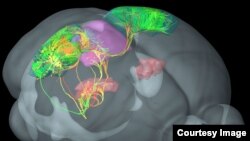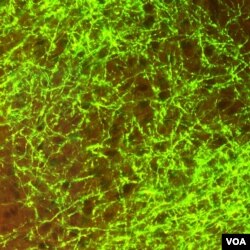Scientists have published two of the most detailed brain maps to date: one tracing the wiring diagram of the mouse brain and the other, an atlas of gene activity in the developing human brain.
The maps are a key tool for researchers seeking to better understand how this incredibly complex organ works, and to study what goes wrong in diseases such as Alzheimer’s and autism.
The publication falls on the first anniversary of a major Obama administration brain research initiative.
The human brain contains roughly 100 billion nerve cells connecting our senses, thoughts, motions, emotions, memories and automatic responses. A good map would help explain how these circuits communicate with each other.
So far, researchers have unraveled the complete mental circuitry of exactly one organism: a tiny worm with just 302 neurons. Other creatures’ brains have been mapped in bits and pieces.
Glowing nerve cells
New research published in Nature puts together a complete map of the brain of a mouse.
The mouse brain is a well-studied stand-in for ours. With around 100 million neurons, it’s less complex but easier to study than the human brain.
Researchers at the Allen Institute for Brain Science injected tiny regions of mouse brains with a virus carrying instructions to make a glow-in-the-dark protein.
The virus would infect a small number of nerve cells and cause each individual cell to glow along its entire length.
The scientists then carved up the mouse brains, one extremely thin slice at a time, and traced the path of those glowing neurons.
The complete map includes a large amount of data: 1.8 petabytes, or the equivalent of a high-definition movie nearly 24 years long.
Memory pathway
The map is just the beginning, however. Scientists will be searching the map for clues that will help them understand brain diseases, such as how memory fails in Alzheimer’s disease.
Mice get a version of the disease that is very similar to the human type. They start to lose brain function even before the characteristic clumps of protein form.
“We would like to understand what is causing that early cognitive decline,” said Allen Institute neuroscientist Hongkui Zeng, who leads the mouse brain mapping project. “One possibility is that it might be very specific but very fine connectional changes in a particular pathway of the brain.”
It could be the pathway that involves memory, for example.
Human development
The other map, published in the same issue of Nature by a different group at the Allen Institute, shows which genes are turned on and off across the brain around halfway through pregnancy.
“The idea is that we can use this map to really try to pin a time and a place where sets of genes associated with disease or sets of genes associated with unique features of the human brain may be active,” said neurobiologist Ed Lein. “And these are probably going to be targeting early developmental events, when these circuits are first set up.”
For instance, his team was able to pinpoint a region of the brain where genes associated with autism were more active.
“It gives us an idea of what kinds of cells may be affected by these genes, and what developmental process,” Lein said. “But also, it pins the timing much earlier. It would suggest that the origin of autism may be quite early prenatally, during the early formation of the cortex.”
Both complete maps will be freely available to other scientists.
The research was published one year after President Barack Obama announced the BRAIN Initiative, short for Brain Research through Advancing Innovative Neurotechnologies."
Announced on April 2 of last year, the $100 million program funds both government and private research efforts.
The maps are a key tool for researchers seeking to better understand how this incredibly complex organ works, and to study what goes wrong in diseases such as Alzheimer’s and autism.
The publication falls on the first anniversary of a major Obama administration brain research initiative.
The human brain contains roughly 100 billion nerve cells connecting our senses, thoughts, motions, emotions, memories and automatic responses. A good map would help explain how these circuits communicate with each other.
So far, researchers have unraveled the complete mental circuitry of exactly one organism: a tiny worm with just 302 neurons. Other creatures’ brains have been mapped in bits and pieces.
Glowing nerve cells
New research published in Nature puts together a complete map of the brain of a mouse.
The mouse brain is a well-studied stand-in for ours. With around 100 million neurons, it’s less complex but easier to study than the human brain.
Researchers at the Allen Institute for Brain Science injected tiny regions of mouse brains with a virus carrying instructions to make a glow-in-the-dark protein.
The virus would infect a small number of nerve cells and cause each individual cell to glow along its entire length.
The scientists then carved up the mouse brains, one extremely thin slice at a time, and traced the path of those glowing neurons.
The complete map includes a large amount of data: 1.8 petabytes, or the equivalent of a high-definition movie nearly 24 years long.
Memory pathway
The map is just the beginning, however. Scientists will be searching the map for clues that will help them understand brain diseases, such as how memory fails in Alzheimer’s disease.
Mice get a version of the disease that is very similar to the human type. They start to lose brain function even before the characteristic clumps of protein form.
“We would like to understand what is causing that early cognitive decline,” said Allen Institute neuroscientist Hongkui Zeng, who leads the mouse brain mapping project. “One possibility is that it might be very specific but very fine connectional changes in a particular pathway of the brain.”
It could be the pathway that involves memory, for example.
Human development
The other map, published in the same issue of Nature by a different group at the Allen Institute, shows which genes are turned on and off across the brain around halfway through pregnancy.
“The idea is that we can use this map to really try to pin a time and a place where sets of genes associated with disease or sets of genes associated with unique features of the human brain may be active,” said neurobiologist Ed Lein. “And these are probably going to be targeting early developmental events, when these circuits are first set up.”
For instance, his team was able to pinpoint a region of the brain where genes associated with autism were more active.
“It gives us an idea of what kinds of cells may be affected by these genes, and what developmental process,” Lein said. “But also, it pins the timing much earlier. It would suggest that the origin of autism may be quite early prenatally, during the early formation of the cortex.”
Both complete maps will be freely available to other scientists.
The research was published one year after President Barack Obama announced the BRAIN Initiative, short for Brain Research through Advancing Innovative Neurotechnologies."
Announced on April 2 of last year, the $100 million program funds both government and private research efforts.









